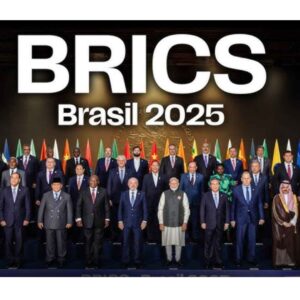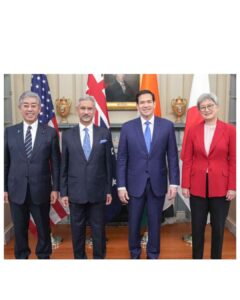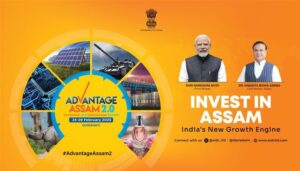
Introduction
In a world marked by geopolitical realignment and rising authoritarian assertiveness, the Quadrilateral Security Dialogue (Quad) has gradually established itself as a pillar of Indo-Pacific stability. The most recent Quad Summit, held on July 1, 2025, in Washington, D.C., represented a watershed moment in the growing minilateral framework. The foreign ministers of India, Japan, and Australia met, hosted by US Secretary of State Marco Rubio, to strengthen their joint commitment to a free, open, and rules-based Indo-Pacific region.
With growing maritime tensions, contested technologies, and supply chain vulnerabilities, this summit switched the Quad’s focus from rhetorical alignment to tangible, practical cooperation. Key issues included marine domain awareness, critical mineral supply lines, rising technological governance, and collective resilience against coercive behaviour, particularly from China. The lack of a prime ministerial-level meeting did not diminish its strategic importance; rather, the emphasis on functional outputs demonstrated the Quad’s desire to evolve into a results-oriented relationship.
For India, the summit brought both continuity and opportunities. Foreign Minister S. Jaishankar emphasized India’s commitment to Indo-Pacific security while negotiating difficult bilateral tensions, such as recent US tariffs and regional power dynamics. As the Indo-Pacific region becomes the focal point of global strategic competition, the Quad’s most recent summit demonstrated its members’ determination to influence, rather than react to, the developing order.
Context and Background
The Quadrilateral Security Dialogue (Quad) has experienced a remarkable transformation, from an ad hoc alliance founded in response to a humanitarian crisis to a strategic platform essential to Indo-Pacific geopolitics.
- The Quad’s genesis lies in the 2004 Indian Ocean tsunami, when India, the U.S., Japan, and Australia coordinated disaster relief operations. This informal cooperation highlighted the value of multilateral coordination among Indo-Pacific democracies.
- In 2007, Japanese Prime Minister Shinzō Abe formally proposed the Quad as a security dialogue focused on shared democratic values and maritime security. However, under pressure from China and due to internal hesitations—especially from Australia—the dialogue dissolved shortly after its first meeting.
- The Quad was revived in 2017 in the face of increasing concerns over China’s assertive behavior in the South China Sea, Belt and Road Initiative (BRI) expansion, and maritime coercion tactics.
- Between 2017–2019, the Quad resumed as a foreign secretary–level dialogue, laying the foundation for gradual institutionalization.
- In 2019, the first foreign ministers’ meeting was held in New York, affirming the members’ commitment to a “free, open, and inclusive Indo-Pacific.”
- The first virtual Quad leaders’ summit was held in March 2021, followed by the first in-person summit in Washington in September 2021.
- During this period, the Quad expanded its agenda beyond security to include:
(i) COVID-19 vaccine production and delivery
(ii) Climate resilience and clean energy
(iii) Cybersecurity and emerging technologies
(iv) Infrastructure investment and regional connectivity
These summits underscored the Quad’s intent to project itself not as a military alliance, but as a platform delivering public goods in the Indo-Pacific.
- With rising tensions in the Taiwan Strait, North Korea’s missile provocations, and the need for resilient technology and mineral supply chains, the Quad established working groups in key areas.
- As of 2025, the Quad operates through ministerial meetings twice a year and an annual leaders’ summit.
- The 2025 Quad Foreign Ministers’ Meeting in Washington, led by U.S. Secretary of State Marco Rubio, emphasized making the Quad a “vehicle for action” rather than just discourse, offering targeted projects on vital minerals, undersea cable security, and artificial intelligence governance.
- Unlike formal alliances like NATO, the Quad is still non-treaty-based and flexible, allowing member nations to cooperate without explicit defence obligations.
- It is today regarded as a key component of Indo-Pacific strategic architecture, balancing China’s influence, maintaining regional stability, and upholding democratic standards.
QUAD 2025 Foreign Ministers Meetings Agreements and Initiatives
In the context of escalating geopolitical tensions and a rapidly changing Indo-Pacific landscape, the Quad Foreign Ministers’ Meeting in Washington, D.C. on July 1, 2025, reiterated the strategic commitment of the four democratic nations- the United States, India, Japan, and Australia. The meeting, hosted by US Secretary of State Marco Rubio, focused on specific deliverables in important areas such as supply chain resilience, maritime security, cyber governance, and counterterrorism. It marked a crucial transition from conversation to action, accelerating the Quad’s emergence into a key pillar of regional stability.
- The summit’s centrepiece was the launch of the Quad Critical Minerals Initiative, which aims to diversify and safeguard supply chains for key minerals such as lithium, cobalt, nickel, and rare earths used in semiconductors and sustainable energy technology.
- Secretary Rubio emphasized the initiative’s goal: “not only access to raw materials, but also the diversification of the global supply chain of critical minerals.”
- About 30–40 companies from Quad countries engaged in initial planning under State Department guidance
- Quad ministers agreed to deepen collaboration on maritime law enforcement, illegal, unregulated, and unreported (IUU) fishing, and counter-piracy.
- Significant initiatives include:
(i) Launch of the Quad‑at‑Sea Ship Observer Mission, with joint deployments to Palau and Guam and expansion of the Indo‑Pacific Maritime Domain Awareness (IPMDA) network
(ii) Upcoming Quad Indo-Pacific Logistics Network training and Quad Ports of the Future Partnership, with Mumbai hosting the first conference in October
- The joint communiqué reaffirmed opposition to any unilateral attempts to alter maritime status quos—implicitly directed at China’s actions in the East and South China Seas.
- It condemned violations of sovereignty, coercion, and threats to maritime and aviation freedoms
- Quad partners have pledged to expand collaboration on safe digital infrastructure, AI ethics, semiconductors, biotechnology, and Open RAN telecom technologies.
- Initiatives include AI-ENGAGE for agricultural innovation, STEM fellowships, and attempts to strengthen undersea cables through the Quad Cable Connectivity and Resilience alliance.
- In response to the March 2025 Myanmar earthquake, the Quad provided over $30 million toward disaster relief.
- The Defence of supply chains extended to include e-waste mineral recovery and digital infrastructure investment.
Condemnation of the Pahalgam Terror Attack
- The Quad foreign ministers unequivocally condemned the April 22 terrorist attack in Pahalgam, Jammu & Kashmir, which claimed 26 lives (25 Indian nationals and one Nepali), dubbing it a “reprehensible act” of cross-border terrorism.
- Foreign Ministers called for the “perpetrators, organizers, and financiers” to be brought to justice without any delay, urging all UN member states to actively cooperate under relevant UNSC resolutions.
- They reaffirmed their unwavering commitment to counter-terrorism cooperation and expressed their condolences and wishes for a speedy recovery to all victims and families.
- Indian External Affairs Minister S. Jaishankar, speaking at the summit, emphasized that “victims and perpetrators must never be equated,” and stressed India’s sovereign right to defend its people against terrorism, urging Quad partners to join in a unified global stance.
India’s Role and Bilateral Engagements
India has been a founding member of the Quad since its early days in 2007, though the initiative lost momentum shortly after. It was revived in 2017 with strong support from India, which viewed the grouping as a strategic counterbalance to China’s growing influence in the Indo-Pacific. Since then, India has consistently used the platform to advocate for a free, open, inclusive, and rules-based Indo-Pacific.
Over the years, India has played a proactive role in shaping the Quad’s strategic direction:
- Hosted the Quad Leaders’ Virtual Summit in March 2021.
- Participated in joint naval exercises like Malabar, which evolved to include all four Quad nations.
- Championed vaccine diplomacy under the Quad Vaccine Partnership, with India’s manufacturing base producing doses for Southeast Asia and the Pacific.
- Played a leading role in climate-focused discussions, technology standards, and space collaboration.
- At the 2025 summit, India projected itself as a key regional stabilizer and economic powerhouse. External Affairs Minister S. Jaishankar led discussions on counter-terrorism, critical mineral processing in the Global South, and maritime security.
- India’s hosting of the upcoming “Ports of the Future” conference in Mumbai was spotlighted as a symbol of New Delhi’s growing logistical and technological footprint. The Indian delegation also emphasized the importance of open, secure, and trustworthy technology ecosystems.
- On the sidelines, Jaishankar held high-level bilateral meetings with Secretary Marco Rubio, Japanese Foreign Minister Gen Nakatani, and Australian Foreign Minister Penny Wong, focusing on:
- Finalizing India’s role in the Quad Cable Connectivity Resilience initiative.
- Accelerating clean energy investments and green hydrogen cooperation with Australia.
- Strengthening trilateral dialogues such as India-Japan-U.S. and India-Australia-Japan frameworks.
- India also used the summit to draw global attention to the Pahalgam terror attack, urging unified condemnation of cross-border terrorism and pressing for expedited reforms to the global counter-terrorism architecture.
Challenges and Divergences within the QUAD
While the Quad showcases unity on several global and regional issues, underlying challenges and divergences persist that could limit its strategic potential:
- Strategic Ambiguities on China: While the Quad countries share concerns over China’s assertiveness, their approaches vary. The U.S. advocates for a strong deterrent stance, whereas India prefers strategic autonomy and avoids overt antagonism.
- Asymmetric Capabilities and Commitments: Member nations differ in defense budgets, technological capacity, and willingness to commit militarily. For instance, Australia’s defense spending commitments have lagged behind U.S. expectations.
- Economic Dependencies: Each Quad country maintains significant trade relationships with China, complicating consensus on sanctions, export controls, or decoupling strategies.
- Differing Regional Priorities: Japan focuses on East Asia, India emphasizes the Indian Ocean, and the U.S. and Australia view the Indo-Pacific more broadly. This geostrategic variation affects alignment on operational priorities.
- Institutional Limitations: The Quad is still an informal grouping without a permanent secretariat, funding mechanism, or legal framework. This restricts its ability to coordinate long-term initiatives efficiently.
Despite these divergences, the Quad remains committed to strengthening coordination through practical cooperation and shared principles.
Conclusion
The 2025 Quad Foreign Ministers’ Summit marked a watershed moment in the evolution of this strategic partnership. By moving beyond dialogue and delivering tangible outcomes—ranging from maritime security and cyber resilience to critical minerals and humanitarian assistance—the Quad demonstrated its growing capacity to shape Indo-Pacific affairs.
India’s influence was particularly pronounced, as seen in the adoption of its security concerns, technological leadership, and diplomatic activism. The unanimous condemnation of the Pahalgam terror attack highlighted how regional security challenges are becoming central to Quad diplomacy.
While challenges persist—be it divergent threat perceptions, economic dependencies, or structural limitations—the commitment to a rules-based order, democratic values, and inclusive growth remains the glue binding the four nations.






